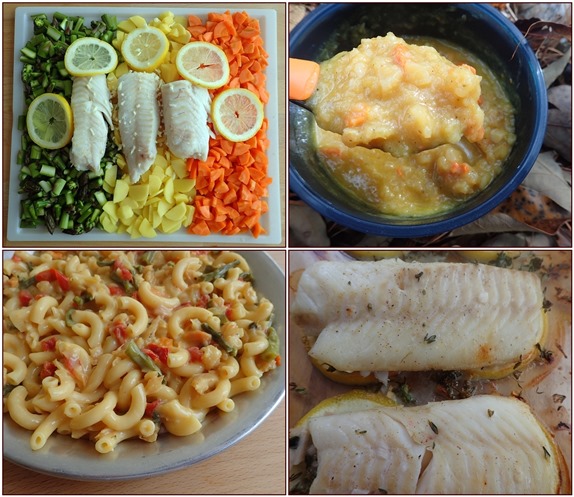Dehydrating Fish: 4 Ways to Cook & Dry It
Dehydrating fish with a home dehydrator is straightforward enough—precook it and spread it on dehydrator trays in strips or small pieces. The challenge comes with rehydrating fish in meals. Fish is mostly protein with no starch. Once it’s dried, it resists rehydration and stays chewy. Long soak times or cooking it first in a chowder or stew improves tenderness.
This page shows how to dehydrate fish after it is cooked in the oven or on the stove, and how to use it in featured recipes like cod casserole, fish-a-roni, fish stew, and fish chowder.
Table of Contents
Safety Facts about Cooking & Dehydrating Fish
How to Dehydrate Sliced Fish (Baked)
Dehydrating Fish Fillets (Baked)
How to Make & Dehydrate Fish Stew (Stovetop)
How to Make & Dehydrate Fish Chowder (Stovetop)
Recipes with Dehydrated Tuna, Shrimp, Salmon, Imitation Crab & Surimi
Safety Facts about Cooking & Dehydrating Fish
Freezing fish suspends microbiological activity, but it does not kill bacteria which may be dormant in the fish.
Thaw frozen fish in the refrigerator, not at room temperature. However, a short thawing outside the refrigerator is fine if you plan to slice half-thawed fillets into strips to cook right away. Also, frozen fish may be added directly to stews and chowders cooked on the stovetop.
Marinating or brining fish with ingredients like wine, vinegar, and salt is not an effective way to kill bacteria or parasites that may be present in fish. A marinade may still be used to add flavor.
To ensure bacteria are killed, fish must be cooked to a minimum internal temperature of 145°F (63°C). Source: US FDA.
Fully-cooked fish (low fat) will be opaque and milky white in color. It will flake easily with a fork when done.
To minimize the risk of dehydrated fish turning rancid in storage, stick with low-fat species.
Medium and high-fat fish, like Atlantic salmon, may be dehydrated, but the dried fish should be vacuum-sealed and stored in the freezer until ready to pack for an adventure. Consume meals with dehydrated, high-fat fish early in your trip.
Fat Content of Fish for Dehydrating
- High-Fat Fish: Atlantic & Chinook species of Salmon.
- Medium-Fat Fish: Bluefish, Catfish, Coho and Sockeye species of Salmon, Rainbow Trout, and Swordfish.
- Low-Fat Fish: Chum & Pink species of Salmon, Halibut, Ocean Perch, Pacific Rockfish, and Tilapia.
- Very Low-Fat Fish: Cod, Flounder/Sole, Haddock, Hake, Mahi-mahi, Pollock, Shrimp, and Tuna.
Dehydrated Fish Storage Recommendations
Vacuum-sealed dried fish may be stored in the freezer for up to 6 months. Outside of the freezer, store high-fat and medium-fat, dried fish in an airtight container for up to 1 month. Store low-fat, dried fish in an airtight container for up to 3 months.
Dehydrating Fish in Slices
The first method of dehydrating fish comes from Johan Sköld of Sweden. Johan’s process involves cutting half-thawed cod into strips and baking them prior to drying. For rehydration, he recommends cold-soaking the dried cod for 4 hours before cooking the full meal at camp.
Cooking & Dehydrating Sliced Cod
Take the fish out of the freezer just long enough until it is halfway thawed.
Cut the cod into 5 mm (¼-inch) thick slices.
Pre-heat oven to 150°C (300°F) while placing the cut cod onto trays. Season to taste. I strongly recommend salt.
Place the trays in the heated oven and cook the cod for 10–15 minutes until the flesh is opaque.
Place the cooked cod on dehydrator trays and dehydrate at 70°C (160°F) until brittle.
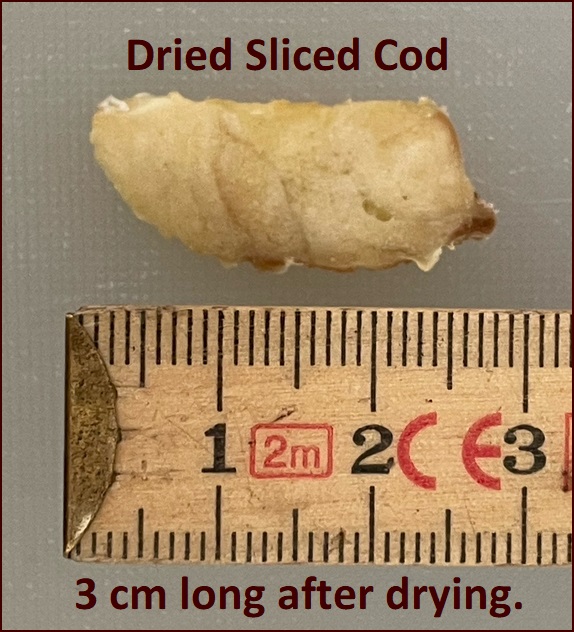
Photo: Sliced cod after dehydrating. (3 cm long)
The weight reduction is about 85%. After dehydration, the 125 g (4.4 oz.) fillet of cod weighs about 18 g (0.6 oz.).
Once cooled, vacuum-seal the cod and place it in the freezer to maximize shelf life.
To see more photos of this fish dehydration technique, Johan recommends visiting Eric Tornblad’s page on the topic. The page is in Swedish, but you can get a good idea of the process from the photos.
Cod Casserole Recipe
Shared by Johan Sköld, Sverige, Sweden
This hearty camping meal from Sweden features dried cod, mixed vegetables, mashed potatoes, and sauce.
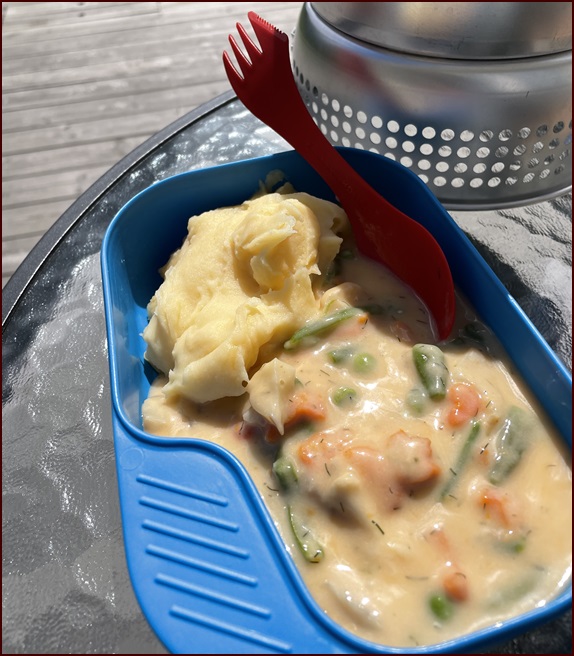
Photo: Johan’s rehydrated cod casserole with vegetables, mashed potatoes, and sauce.
Servings: 1
Ingredients:
- 125 g fillet of cod (4.4 oz.) Weight before drying
- 125 g frozen vegetable mix (4.4 oz.) Weight before drying
- 1 packet powdered sauce mix suitable for fish dishes
- 1½ portion instant mashed potatoes
Optional: Dehydrated shrimp for extra taste
At Home:
Dehydrate the Fish (as previously described)
Dehydrate the Frozen Vegetables: Thaw the vegetables and cut larger pieces in half (or even quarters). Place on dehydrator trays and dehydrate at 50°C (125°F) until brittle.
The weight reduction is about 85%. After dehydration, 125 g (2.2 oz.) of frozen vegetables weigh about 16 g (0.6 oz.).
Packaging: Pack powdered sauce mix, instant mashed potatoes, dried vegetables, and dehydrated fish in separate bags, since they are added in stages when rehydrating the meal.
On the Trail:
Cold soak the cod for at least 4 hours prior to cooking.
Boil water for mashed potatoes and store in thermos.
Place the pre-soaked cod in a pan, add water, and bring to boil. Transfer pan to an insulating cozy for 20 minutes.
Place the vegetables in same pan as the cod with just enough water to cover cod and vegetables.
Bring to boil and place in cozy for an additional 10 minutes to let the vegetables rehydrate.
Add sauce mix to pan with cod and vegetables. Bring to boil while stirring. Add water if required. Transfer pan to a cozy while preparing the mashed potatoes.
Mix the instant mash in separate pan or bowl. Plate up and enjoy.
Variation: For a bit more texture, you can use dehydrated, grated potatoes instead of mashed potatoes.
Dehydrating Fish Fillets
This method of dehydrating fish involves baking the fillets with aromatics and then pulling the cooked fish apart into smaller pieces to dry.
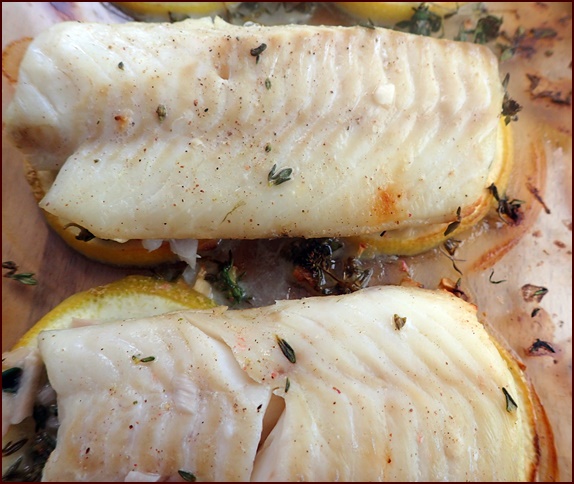
Photo: Baking cod on top of lemon slices, garlic, and thyme. Hake, a low-fat fish similar to cod can also be used.
Baking Instructions:
Thaw frozen fish in refrigerator the night before using. Pat fish dry with paper towels.
Preheat oven to 400°F (200°C).
Place thin slices of lemon in glass baking dish—enough to put 2 slices under each fillet. Top with minced garlic and sprigs of thyme.
Rub fish fillets generously with salt and pepper to taste. Place fish fillets on top of lemon slices. Squeeze a little lemon juice over top of fish.
Bake for 15 minutes, then flip the fish over. Spoon any loose juices over fish. Bake an additional 5–10 minutes. Fish is done when opaque and milky white in color. It will flake easily with a fork.
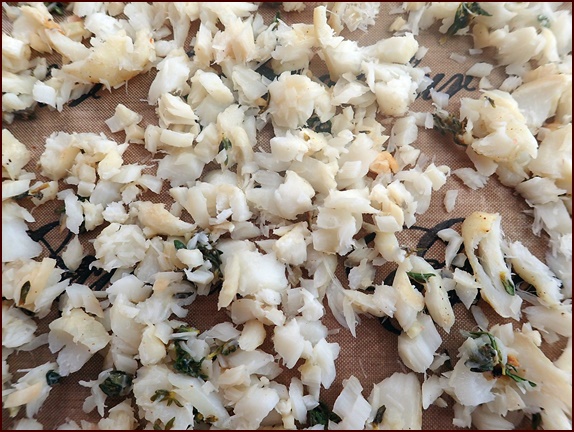
Photo: Cooked cod after shredding with a fork, on dehydrator tray covered with nonstick sheet.
Dehydrating Instructions:
Pull cooked fish apart into smaller pieces using two forks and transfer shredded fish to dehydrator tray covered with nonstick sheet.
Dehydrate at 145°F (63°C) for 4–6 hours. Fish will be brittle when dry. Because the fish was fully cooked at a high temperature, and the drying time quite short, dehydrating above 145°F (63°C) is not necessary.
Yield: 2¼ cups of shredded cod (283 g), will reduce to 1 cup dried (81 g).
Rehydration: As with Johan’s dried cod slices, these dehydrated fish pieces need a long soak in hot or cold water (2-4 hours) to rehydrate. The fish tastes great in the following recipe, but it’s still chewy even after extended soaking.
Fish-a-Roni Recipe
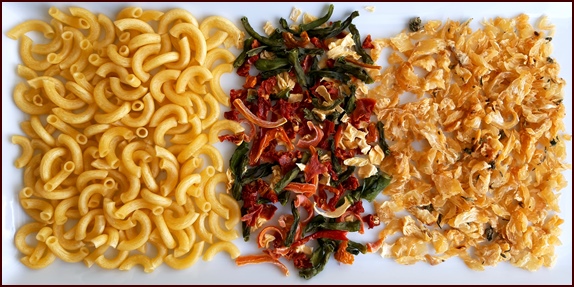
Photo: Ingredients for Fish-a-Roni recipe: dehydrated macaroni, mixed vegetables, and fish.
Servings: 1
Ingredients:
- ½ cup precooked & dried macaroni (45 g) *
- ¼ cup dried fish (20 g)
- ¼ cup dried mixed vegetables (15 g) **
- 2-3 Tbsp. powdered sauce mix (12–18 g) ***
* Dried shells or linguine are also suitable types of pasta.
** For variation, try dried asparagus in the vegetable mix.
*** Any type of powdered cheese or hollandaise sauce will work. Depending on the ingredients in the mix, you may want to include a tablespoon of powdered milk for extra creaminess. If you carry a block of cheese, you can make your own cheese sauce. See How to Make Cheese Sauce with Real Cheese.
Pack macaroni and vegetables in one bag, fish in another bag, and sauce powder in a third bag.
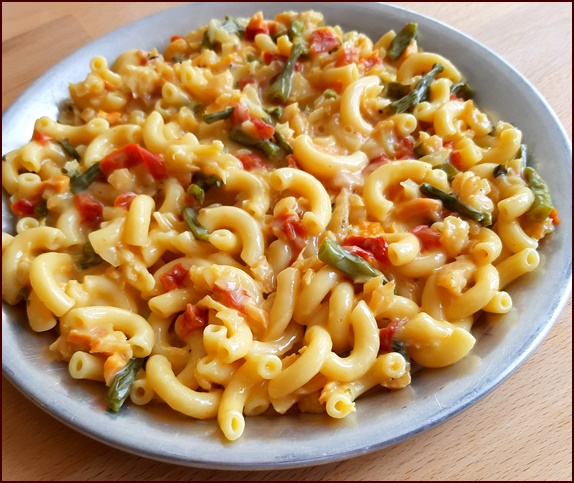
Photo: Rehydrated Fish-a-Roni
On the Trail:
Begin soaking dried fish by itself in hot or cold water well in advance of meal time. A thermos food jar works well for advance soaking.
Place soaked fish, macaroni, and vegetables in a pot and soak for 5 minutes.
Light stove and bring to a boil for 1 minute.
Transfer pot to an insulating cozy and let sit for 10 minutes.
Stir in sauce powder and wait another 10-15 minutes with pot in cozy before eating.
Dehydrating Fish that is Less Chewy
Instead of baking fish in the oven, the next two cooking methods show how to cook fish on the stove in stew or chowder. Simmering the fish in liquid breaks it down more than baking. You get all the fish taste without the need for long soak times.
How to Make & Dehydrate Fish Stew
Cod or hake are both good choices of fish for fish stew. The fish is poached in a flavorful broth with vegetables.
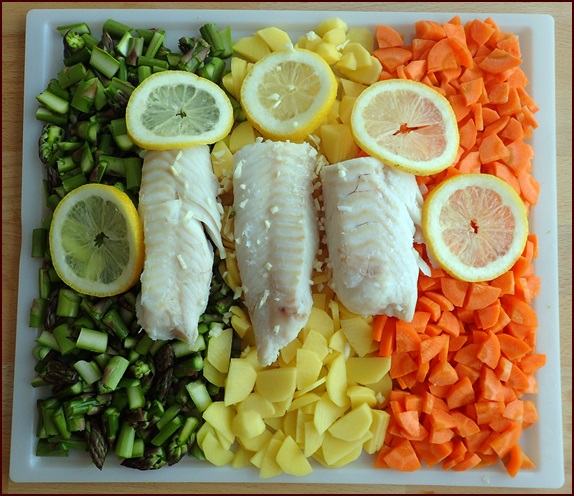
Photo: Fresh ingredients for fish stew include asparagus, potatoes, and carrots.
Servings: 3
Ingredients:
- 12 oz. cod or hake fillets (340 g)
- 8 oz. carrots (227 g, 2 cups diced)
- 8 oz. asparagus (227 g, 2 cups diced)
- 8 oz. potatoes (227 g, 2 cups diced)
- 1 clove garlic
- ½ lemon, sliced
- 2 tsp. dried parsley
- 2 tsp. dried chives
- 1 tsp. dried tarragon
- 1 tsp. salt
- ¼ tsp. ground peppercorns
- 2 bay leaves
- 2¾ cups water (650 ml)
- ¼ cup dry white wine (60 ml)
Cooking Procedure:
Remove fish from freezer and rinse off any frost under cold water.
Place frozen fish in a stock pot with water. Turn stove on lowest setting to thaw fish while you process the vegetables.

Cut the vegetables into small pieces so that all ingredients, once cooked, will dry uniformly.
- Cut off and discard the fibrous bottom part of the asparagus—usually about an inch or two. If the asparagus stalks are thick, peel the lower halves and then cut them in half longwise. Then slice across into pieces ¾–1 inch long (2 cm).
- Cut peeled potatoes into halves or quarters, depending on the size you are using. Then slice across thinly.
- Cut peeled carrots into halves or quarters longwise, and then slice thinly across.
When you finish cutting the vegetables, the fish will be thawed and partially cooked in the water. If you like a strong fish taste, use the liquid in the pot for the stew. If you prefer a milder fish taste, drain off the water and replace with fresh water.
For the white wine ingredient, Sauvignon Blanc or Chardonnay are good choices.
Remove the fish to a plate and add all other ingredients (except the lemon slices) to the pot. Bring to a boil and then reduce to light simmer for 10 minutes.
Shred the fish with 2 forks, then add it to the pot with the lemon slices. Bring back to a boil for 2 minutes, then reduce to light simmer for 3 minutes.
Remove stew from heat and let sit with lid on pot for 10 minutes.
Dehydrating Fish Stew
Allow stew to cool slightly before putting it in a dehydrator.
If using a dehydrator with nonstick trays that have raised outer rims, divide the stew into 3 servings (2 cups on each tray), including all the liquid.
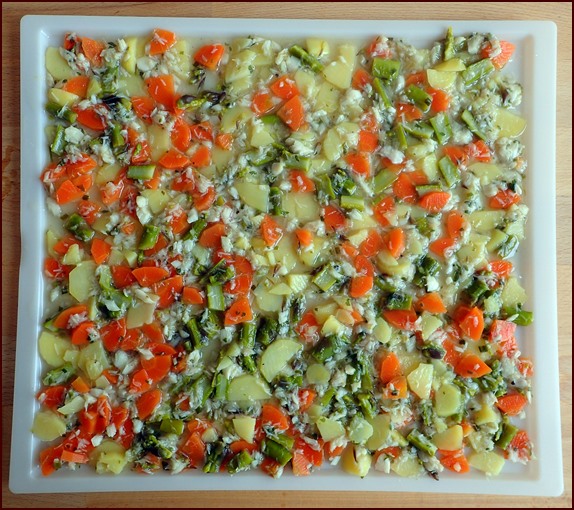
Photo: 2 cups of cooked fish stew on Cosori dehydrator tray.
If using a dehydrator with nonstick sheets that do not have rims, mash some of the potatoes with the liquid to thicken it up enough so that it does not run off the sheets. Alternatively, you can hold back some of the liquid and add it back in stages during the first hour of dehydration. Liquid evaporates fast in a dehydrator, leaving the flavor behind.
Dehydrate fish stew at 145°F (63°C) for 6—8 hours.
After 3 hours, scrape partially-dried stew off nonstick trays/sheets with a sturdy plastic spatula, working from the outside edges to the center. Pull apart stew pieces and redistribute on trays/sheets for remaining time.
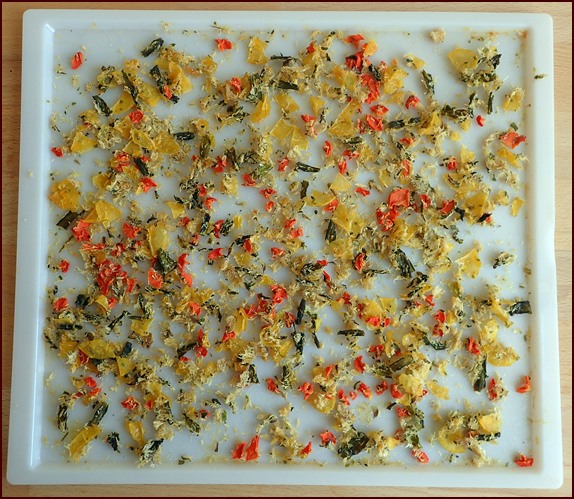
Photo: One serving of fish stew after dehydrating.
Yield: This recipe as described produces approximately 6 cups of fish stew before drying (1288 g). After dehydration, the volume is approximately 2¼ cups (156 g).
Packing & Storage: Divide dehydrated fish stew into 3 servings, which will be about ¾-cup each. If desired (recommended), add additional vegetables dried separately to make full, 1-cup servings. Store in airtight containers such as vacuum-sealed bags or jars with O2 absorbers.
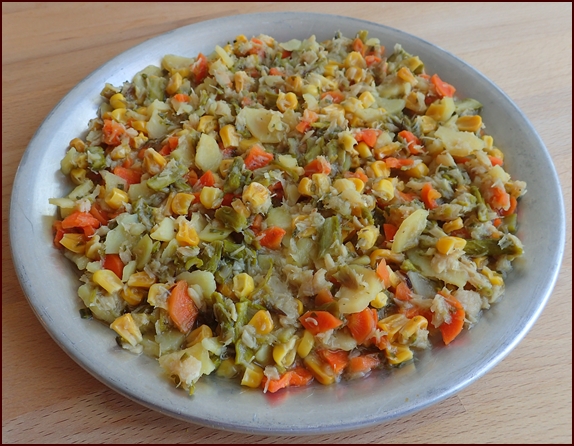
Photo: Rehydrated fish stew. Although you can’t see it, there is a tasty broth lurking under the fish and vegetables.
On the Trail:
Combine 1 cup dehydrated fish stew with 1½ cups water. For the meal shown in the photo above, ¾-cup of dried stew was combined with ¼-cup dried corn. Extra dried asparagus would also be a good choice.
Let soak 5–10 minutes. Light stove and bring to a boil for 1 minute. Transfer pot to an insulating pot cozy and let sit for 20 minutes.
This meal can also be rehydrated with boiled water in a thermos food jar.
Dehydrated
Fish Chowder Recipe
This recipe is featured in Recipes for Adventure II: The Best of Trail Bytes.
Dehydrating fish chowder for the trail requires that you omit dairy ingredients like milk, cream, and butter. Dairy products can spoil if included in dehydrated meals. Powdered milk can be added when rehydrating the meal on the trail. This dehydrated fish chowder recipe is still very hearty because a portion of it is run through a blender to make it thick.
Servings: 5 (2-cup portions)
Ingredients:
- 1 Tbsp. cooking oil
- 1 large onion (1 cup, diced)
- 4 stalks celery (1 cup, diced)
- 4 large carrots (1½ cups, sliced)
- 8 medium red potatoes (4 cups, diced)
- 2 lbs. frozen cod or hake fillets (900 g), thawed and cut into small chunks
- 2 tsp. salt
- ½ tsp. black pepper
- 1 tsp. Old Bay seasoning (or similar fish seasoning)
- 3 bay leaves
- 4 cups water
Optional: 2–3 Tbsp. milk powder per serving to be added when rehydrating the chowder on the trail.
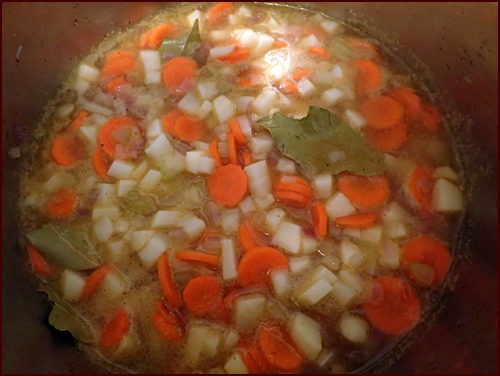
Photo: Vegetables and seasonings simmering before fish was added.
How to Make Fish Chowder
Cook onion and celery using 1 tablespoon cooking oil in stock pot over medium heat, about 5 minutes.
Add carrots, potatoes, all seasonings, and 4 cups of water to pot. Bring to a boil, then reduce to simmer for 10 minutes.
Cut thawed fish into smaller pieces and add to pot. Bring to a boil, then reduce to simmer for 10 more minutes.
Remove 6 cups of chowder from the pot and run it through a blender. This will thicken it up enough so that it won’t run off the dehydrator trays. Keep most of the carrots in the portion that doesn’t get blended. If you don’t want to dirty your blender, you can use a hand masher.
Stir the blended portion back into the unblended chowder. The chowder thickens as it cools.
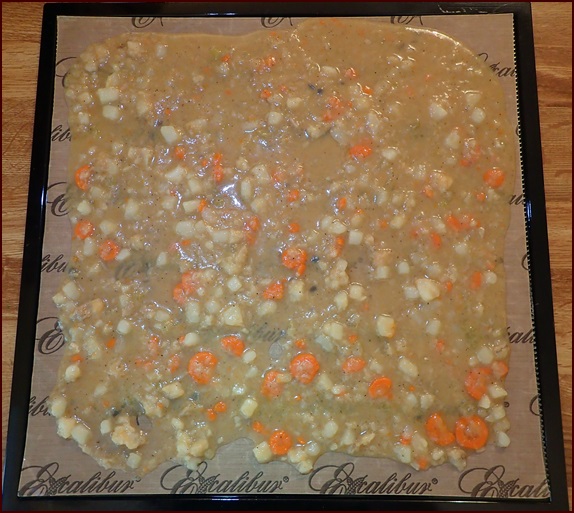
Photo: 2 cups of chowder dehydrating on Excalibur dehydrator tray.
Dehydrating Fish Chowder
Spread chowder on dehydrator trays covered with nonstick sheets. This recipe produces 10 cups of chowder – 2 cups per Excalibur Dehydrator tray, using 5 trays. Two cups is also a serving size, so drying this quantity on each tray makes it easy to transfer the dried results directly into individual storage bags.
Dehydrate at 145°F (63°C) until completely dry, approximately 10–12 hours.
After 5 hours, scrape partially-dried stew off nonstick trays/sheets with a sturdy plastic spatula, working from the outside edges to the center. Pull apart chowder pieces and redistribute on trays/sheets for remaining time.
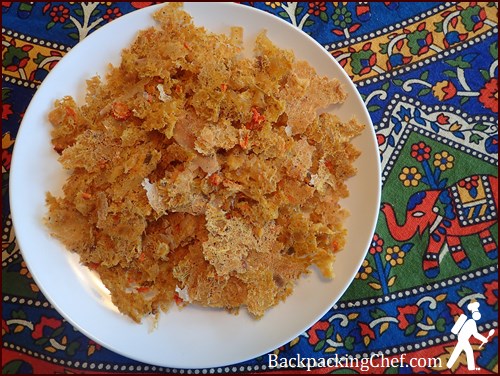
Photo: A closer look at dried fish chowder. It crumbles easily. The portion shown above is from 2 cups of wet chowder dried on 1 tray. The dried yield was 1 cup, firmly packed.
On the Trail:
The ratio of water to dried food for rehydration is 1:1 when preparing in a pot. Increase water by 25% for thermos cooking.
One cup of packed dried chowder weighs approximately 55 grams.
Serving Size Recommendations:
One cup of dried chowder rehydrated with 1 cup of water makes a decent-sized lunch portion, especially if you have something else to eat with it.
For a dinner serving or more substantial lunch, go with 1½ cups of dried chowder rehydrated with 1½ cups water.
Folks with hearty appetites can make a large serving out of 2 cups of dried chowder rehydrated with 2 cups of water. Confession: This chowder is addictive. I have no problem eating a large, 2-cup serving.

Photo: Serving of rehydrated fish chowder prepared in a pot.
Cooking in a Pot: Combine dried chowder and water in pot. Soak 5 minutes. Light stove and bring to boil. Remove from heat and transfer pot to an insulating cozy. Wait 10–15 minutes.
Cooking in a Freezer Bag: Add boiled water to dried chowder in freezer bag. Place bag in an insulating cozy pouch and wait 20 minutes.
Cooking in a Thermos Food Jar: Add boiled water to dried chowder in thermos food jar. Wait 20 minutes up to several hours. Chowder thickens with longer soak times. The maximum quantity of dried chowder that a 24-ounce capacity thermos food jar will hold, allowing for the water to be added, is 2 cups.
Explore More…
Dehydrated
Fish & Seafood Recipes
Backpacking Recipes with Tuna:
Recipes with Tuna: Pasta with Tuna Sauce, Tuna Mac & Cheese, Tuna & Rice with Vegetables, Tuna Zuppa, Tuna & Pasta San Marzano, Tuna Salsa Salad, and Tuna Snack Pack.
Backpacking Recipes with Shrimp:
Salmon, Imitation Crab & Surimi:
Salmon Recipes: Salmon Cakes, Spicy Salmon & Noodles, Smoked Salmon Chowder.
Sushi Rice Bowl (cold-soak salad with surimi)
Food Drying & Trail Cooking Gear Guide
Products to help you with your food drying projects and trail cooking adventures. I use the featured products regularly, or they are recommended by Backpacking Chef readers.
Share this page with friends on social media.
Free E-book & Newsletter
Free with Trail Bytes subscription.
Dehydrating Food from A–Z

